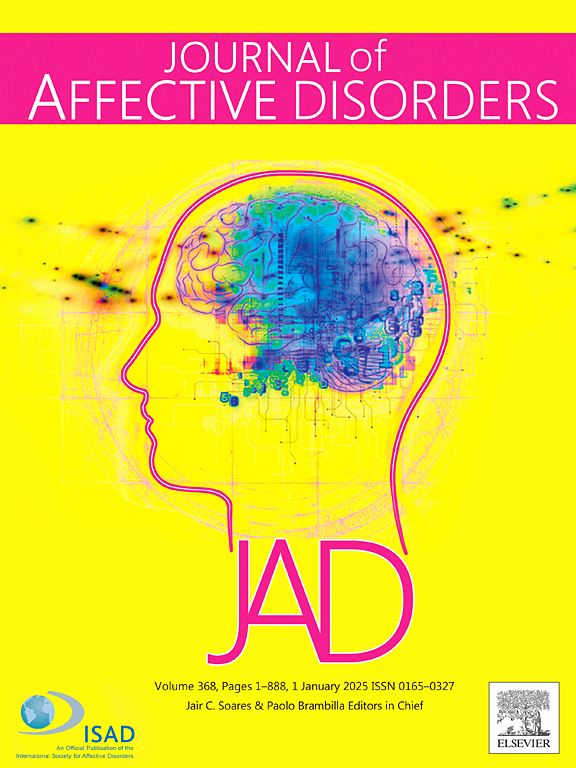自我批评可预测重度抑郁症患者间歇性脑波爆发刺激的抗抑郁效果。
IF 4.9
2区 医学
Q1 CLINICAL NEUROLOGY
引用次数: 0
摘要
背景:自我批评是抑郁症的一个危险因素,然而高程度的自我批评与重复性经颅磁刺激(rTMS)带来的更大的抗抑郁效果相关,这表明自我批评可能是目标回路功能的代表。我们使用rTMS治疗试验的辅助数据来验证这一假设,该试验使用NMDA受体激动剂(d -环丝氨酸)来增强TMS突触可塑性以提高疗效。我们假设,当刺激与d -环丝氨酸配对时,自我批评与治疗结果的关系比与安慰剂的关系更强。方法:在一项为期4周的单点双盲随机安慰剂对照试验中,50名患有重度抑郁症(MDD) (NCT03937596)的成人患者随机接受安慰剂或d -环丝氨酸(100 mg),每日对左背外侧前额叶皮层(DLPFC)进行间歇性θ -burst刺激(iTBS)。在基线和治疗后,使用抑郁经历问卷作为次要试验结果评估自我批评,使用临床医生评定的蒙哥马利阿斯伯格抑郁评定量表(MADRS)评估抑郁症状。临床缓解定义为MADRS降低≥50% %。结果:自我批评对抗抑郁效果的预测存在差异,MADRS和临床反应的百分比均下降(≥50% %下降),iTBS+ d -环丝氨酸组与iTBS+安慰剂组的相关性具有统计学意义。在治疗过程中,两种情况下的自我批评都没有显著改变。结论:我们的数据表明,左DLPFC的iTBS参与了一个与自我批评相关的回路。高水平的自我批评预示着对iTBS有更好的反应,这种辅助剂可以增强突触的可塑性。这表明人格特征可以用于定制非侵入性神经刺激治疗。本文章由计算机程序翻译,如有差异,请以英文原文为准。
Self-criticism predicts antidepressant effects of intermittent theta-burst stimulation in Major Depressive Disorder
Background
Self-criticism is a risk factor for depression and depressive symptom persistence, however higher degrees of self-criticism have been associated with greater antidepressant benefits from repetitive transcranial magnetic stimulation (rTMS), suggesting that self-criticism may act as a proxy for function of the targeted circuit.
We test this hypothesis using secondary data from an rTMS treatment trial where an NMDA receptor agonist (D-Cycloserine) was used to enhance TMS synaptic plasticity to improve efficacy. We hypothesized that self-criticism would be more strongly associated with treatment outcome when stimulation was paired with D-Cycloserine than with a placebo.
Methods
In a 4-week single-site double-blind randomized placebo-controlled trial, fifty adults with Major Depressive Disorder (MDD) (NCT03937596) were randomized to receive placebo or D-Cycloserine (100 mg) with daily intermittent theta-burst stimulation (iTBS) to the left dorsolateral prefrontal cortex (DLPFC). At baseline and after treatment, self-criticism was assessed using the Depressive Experiences Questionnaire as a secondary trial outcome and depressive symptoms were assessed using the clinician rated Montgomery Asberg Depression Rating scale (MADRS). Clinical response was defined as a ≥50 % decrease on the MADRS.
Results
Self-criticism differentially predicted antidepressant effects when operationalized as both percent decrease on the MADRS and clinical response (≥50 % decrease), with a statistically significantly stronger association in the iTBS+D-Cycloserine group than the iTBS+Placebo condition. Self-criticism did not significantly change in either condition over the course of treatment.
Conclusions
Our data suggests that iTBS to the left DLPFC engages a circuit related to self-criticism. Higher levels of self-criticism predicted better response to iTBS with an adjuvant that enhances synaptic plasticity. This suggests that personality traits may be used to tailor non-invasive neurostimulation treatments.
求助全文
通过发布文献求助,成功后即可免费获取论文全文。
去求助
来源期刊

Journal of affective disorders
医学-精神病学
CiteScore
10.90
自引率
6.10%
发文量
1319
审稿时长
9.3 weeks
期刊介绍:
The Journal of Affective Disorders publishes papers concerned with affective disorders in the widest sense: depression, mania, mood spectrum, emotions and personality, anxiety and stress. It is interdisciplinary and aims to bring together different approaches for a diverse readership. Top quality papers will be accepted dealing with any aspect of affective disorders, including neuroimaging, cognitive neurosciences, genetics, molecular biology, experimental and clinical neurosciences, pharmacology, neuroimmunoendocrinology, intervention and treatment trials.
 求助内容:
求助内容: 应助结果提醒方式:
应助结果提醒方式:


